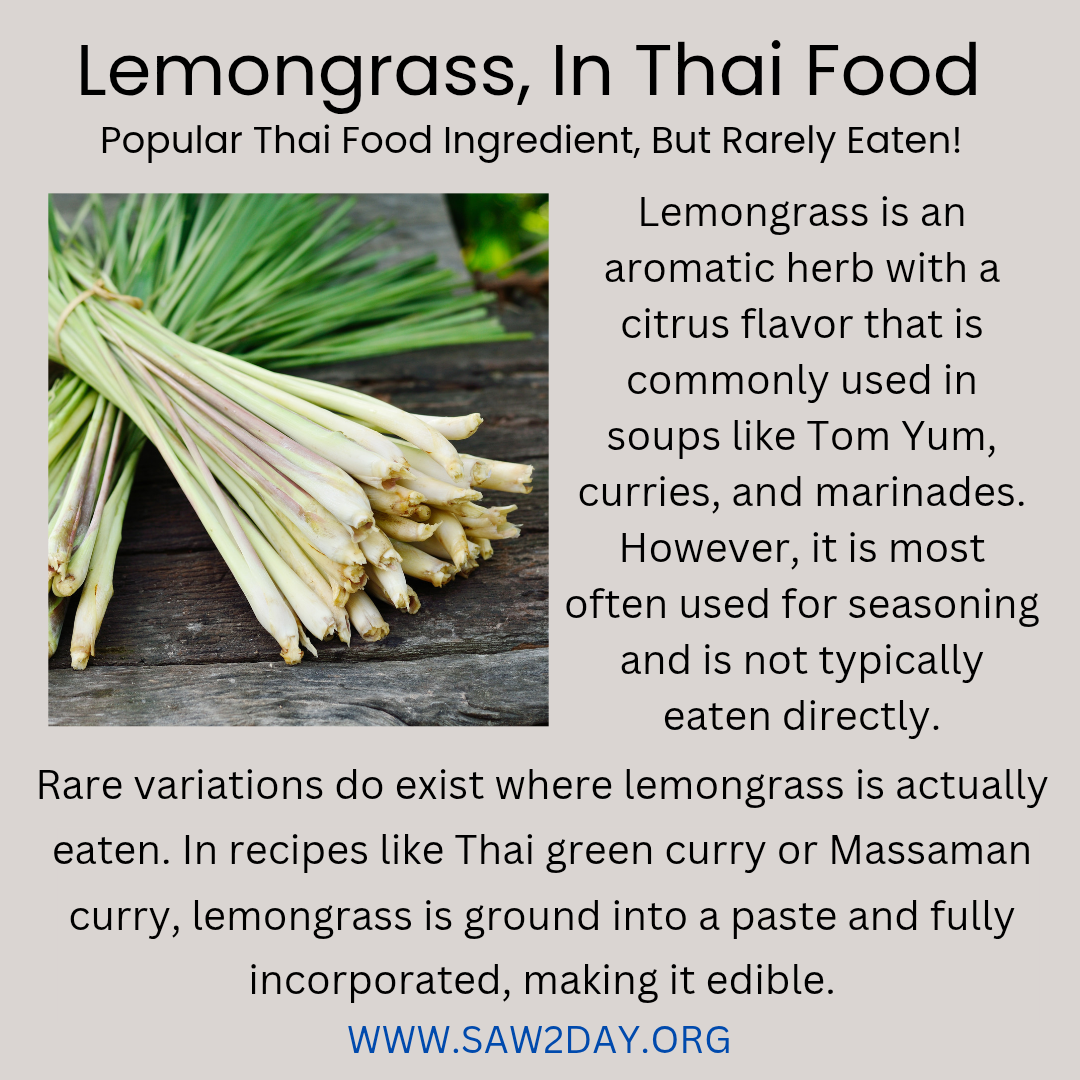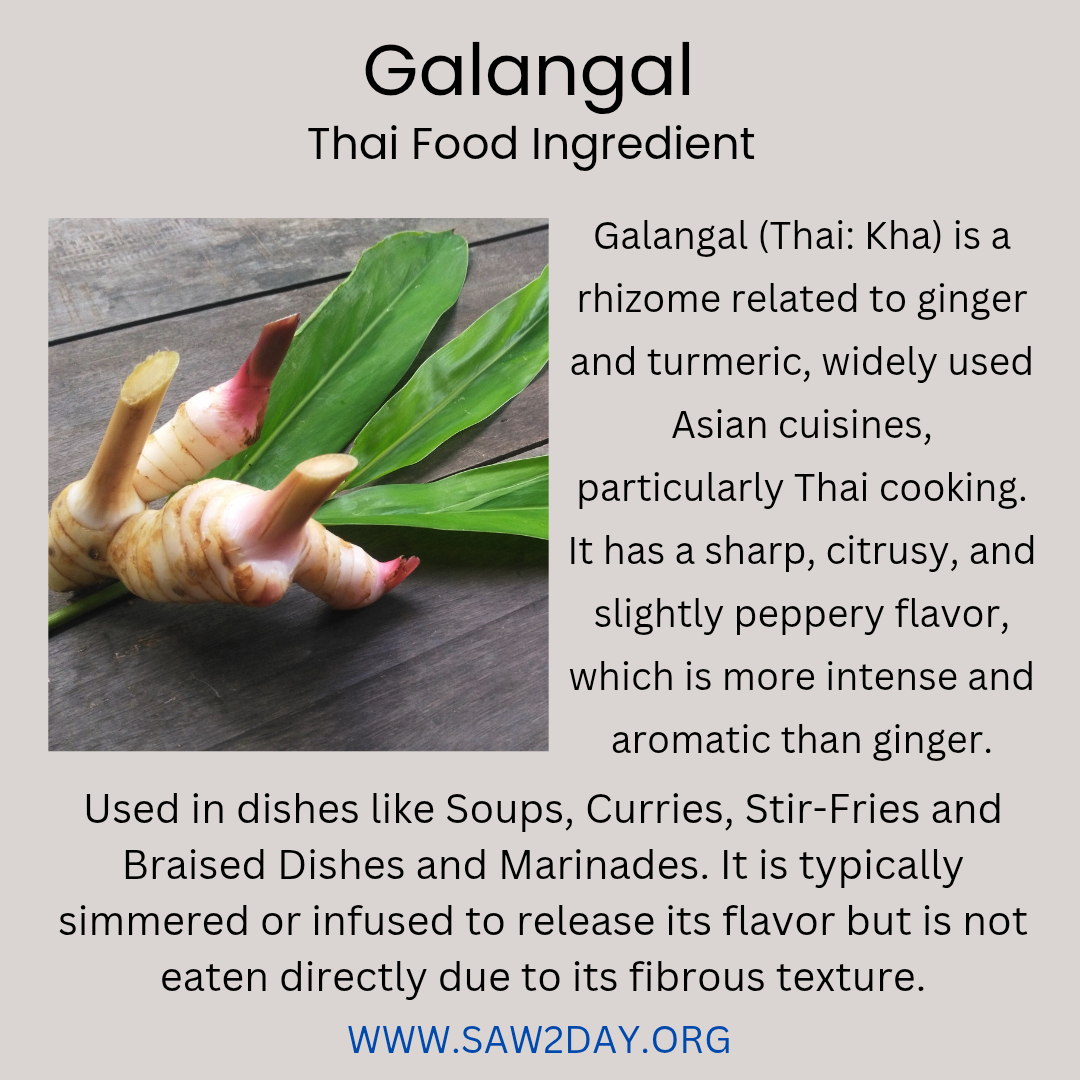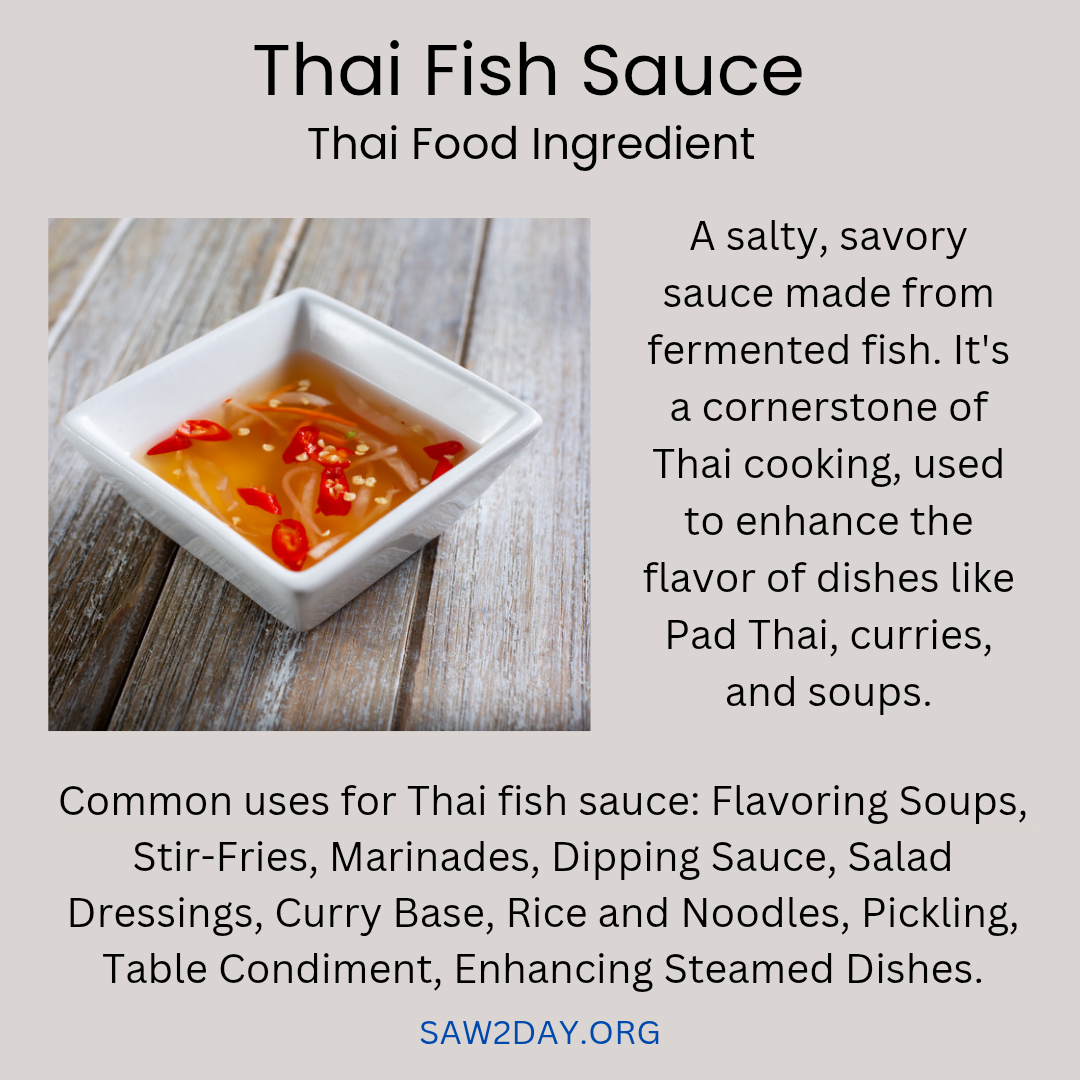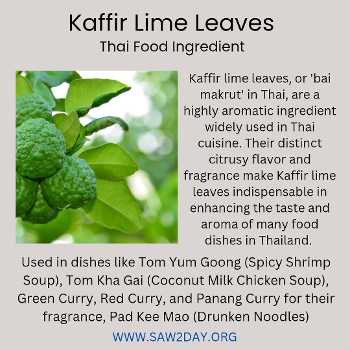Thai Food Ingredients, Top 4
This report lists some of the most popular ingredients used in cooking Thai food. Thai food relies heavily on a range of ingredients to create its unique and flavorful taste. It is true that a number of ingredients have a role to play in adding flavor to Thai food dishes - we talk about 4 very commonly used Thai food ingredients.
4 POPULAR THAI FOOD INGREDIENTS
- Lemongrass ... (ตะไคร้ - Ta-khrai)
- Fish sauce ... (น้ำปลา - Nam Pla)
- Galangal ... (ข่า - Kha)
- Kafir lime leaves ... (ใบมะกรูด - Bai Makrut)




Lemongrass (ตะไคร้ - Ta-khrai)
Adds a citrusy, aromatic flavor to soups, curries, and marinades, such as in *Tom Yum* soup. Lemongrass is used in a variety of dishes, both savory and sweet, to enhance the taste and add a refreshing note.
Lemongrass is a key flavoring ingredient in the famous tom-yum hot and sour soup, paired with galangal, kaffir lime leaves, and chili. Many Thai food recipes use lemon grass, it pairs well with many other popular ingredients used in Thai cooking.
Tom Kha Kai is a creamy coconut milk-based soup, this is another very famous soup in Thailand. Lemongrass as an ingredient in Tok Kha Kai adds a zesty flavor to the dish.
In the famous red and green curry pastes, fresh lemongrass is ground to a paste and added - to the other ingredients. In this case, the lemongrass is consumed as it is in the form of a paste and blends, into the other ingredients.
Lemongrass is a prominent ingredient used to marinate meats like chicken or pork, often mixed with garlic, shallots, and soy sauce, to infuse a bright, citrusy flavor.
Thai cooks at times use lemongrass to be infused in rice during cooking or chopped and mixed in fried rice for a subtle citrus aroma. The other popular Thai ingredient that is used more often than, lemongrass to infuse into rice is pandan leaves.
Lemongrass tea is a popular herbal drink in Thailand, often served hot or iced for its soothing and aromatic properties. You need to develop a taste for this beverage, so being with a small quantity and check if you like it.
Some Thai desserts are made by infusing lemongrass into syrups or coconut milk used in desserts for a unique twist.
A few tips on how to use lemongrass when cooking Thai food. The tougher outer layers of lemongrass are usually removed, and the tender inner stalk is sliced, minced, or pounded to release its oils. Most Thai food recipes that have lemongrass as an ingredient, will provide clear instruction regarding how the lemongrass is to be prepared before, being added in the cooking process.
Sometimes, lemongrass is bruised and used whole in soups and curries, allowing its essence to infuse the dish, then removed before serving. So when lemongrass is ground into a paste or cut into a fine slices, it could be completely consumed.
Fish Sauce (น้ำปลา - Nam Pla)
A salty, umami-packed condiment essential for seasoning, found in everything from *Som Tam* (papaya salad) to stir-fries. Fish sauce is a cornerstone ingredient in many Southeast Asian cuisines, especially Thai, Vietnamese, and Filipino. It’s a fermented condiment made from fish (typically anchovies) and salt, offering a unique combination of salty, umami, and slightly sweet flavors that elevate Thai food dishes to another level.
Thai fish sauce is salty, savory, and packed with umami. An interesting thing about this often used Thai food ingredient is that, it is pungent when smelled on its own, but mellows and blends beautifully when cooked. The color of fish sauce can range from amber to deep brown. The color depends on the consistency of the fish sauce and also, on subtle variations of the proportions of ingredients used to make the fish sauce.
Fish sauce is used instead of or alongside salt in dishes to provide depth and complexity. When making Thai food dishes that use both fish sauce an salt, use both ingredients in moderation. You would obviously not want your dish to become too salty! When fish sauce is mixed with lime juice, sugar, garlic, and chili, it becomes nam pla prik, a versatile Thai dipping sauce.
Fish sauce is often added as an ingredient in broths like tom yum or tom kha gai to deepen the savory flavor. Fish sauce enhances the flavor of coconut-based curries and wok-fried dishes. Depending on the other ingredients used in the Thai dish that you are cooking - keep a watch on the fish sauce that you add, you might want to ensure that the flavor of other ingredients is also retained. Fish sauce is key in dressings for salads like som tam (green papaya salad).
Now some tips on using fish sauce in Thai cooking. A little goes a long way—add a teaspoon or so of fish sauce at a time and adjust to taste. When using fish sauce in certain dishes, it is a good idea to pair fish sauce with other flavors like lime, sugar, or chili to create a balanced dish. Many people are put off by the strong smell of fish sauce, interestingly they get over that after a while and appreciate the unique flavor, that this ingredient imparts to Thai food.
Galangal (ข่า - Kha)
A rhizome similar to ginger but with a sharper, peppery taste, often used in *Tom Kha Gai* (chicken coconut soup) and curries. Galangal** (ข่า - Kha) is a quintessential ingredient in Thai cuisine, known for its distinct flavor and aromatic properties. Galangal is a rhizome, popular with most Thai chefs.
Galangal has a sharp, earthy, slightly spicy, and pine-like flavor with citrusy undertones. This rhizome is tougher and more fibrous than ginger, this is the reason why this Thai food ingredient usually sliced or pounded before use.
Galangal is a prominent ingredient in *Tom Kha Gai* (chicken coconut soup) and *Tom Yum Goong* (spicy shrimp soup from Thailand), where it adds a warm, aromatic base. Sliced or pounded galangal is often added to curry pastes, such as in Thai red or green curry, to provide depth of flavor. This popular ingredient in Thai cooking is used whole or sliced, in broths and stews to infuse the liquid with its unique flavor.
Always peel the tough skin on Galangal before using it. If fresh galangal isn’t available, dried or powdered galangal can be used, though the flavor will be less intense.
Here is an added and important piece of information related to this very popular ingredient used in Thai food cooking. Galangal is often used to infuse flavor into Thai dishes, acting as a key aromatic ingredient rather than something meant to be consumed directly. Its tough, fibrous texture makes it difficult to chew or digest, so it’s typically set aside while eating.
There are exceptions where Galangal is fully consumed (eaten). Galangal is almost always added as an ingredient in curry pastes in Thailand. When making Thai curry pastes, galangal is finely pounded with other ingredients like lemongrass and chilies. In this form, it’s fully blended into the dish and cannot be removed.
Kaffir lime leaves** (ใบมะกรูด - Bai Makrut)
An essential ingredient in Thai cooking, Kaffir lime leaves are cherished for their distinct citrusy aroma and flavor. Here's how Kaffir lime leaves are typically used and their role in Thai cuisine. As a commonly used ingredient in Thai cooking, kaffir lime leaves enhance the flavor of many Thai food dishes.
The leaves add a zesty, aromatic note to soups, curries, and stir-fries. Examples of Thai kaffir lime leaves, being used as a prominent ingredient in Thai food cooking. Tom Yum Goong* (Spicy shrimp soup), Tom Kha Gai* (Chicken coconut soup).
Finely sliced or torn kaffir lime leaves are added to red, green, and panang curries for a citrusy lift. These leaves are often shredded and sprinkled into Thai stir-fried dishes for an extra punch of flavor. In dishes like yum nua (Thai beef salad), kaffir lime leaves add a refreshing aroma and complexity.
Kaffir lime leaves are also added as a flavoring ingredient to fish cakes. The leaves are finely chopped and mixed into the fish paste, giving the fish cakes their characteristic taste.
Some quick tips on using Kaffir lime leaves as an ingredient in Thai food dishes. When using the leaves, remove the tough central vein to make slicing easier and the texture more palatable. Torn Kaffir lime leaves release their aroma more effectively, while finely slicing them allows for even distribution in dishes.
Kaffir lime leaves are not usually eaten whole (due to their tough texture) but are instead used to infuse their flavor into food. However, finely sliced leaves are sometimes eaten when incorporated into certain recipes
We do hope that you have found this information related to popular ingredients in Thailand useful. We request you to recommend the link of this webpage to your family or friends.
